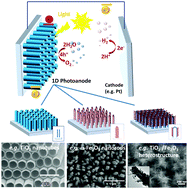当前位置:
X-MOL 学术
›
Chem. Soc. Rev.
›
论文详情
Our official English website, www.x-mol.net, welcomes your feedback! (Note: you will need to create a separate account there.)
Photoanodes based on TiO2 and α-Fe2O3 for solar water splitting – superior role of 1D nanoarchitectures and of combined heterostructures
Chemical Society Reviews ( IF 46.2 ) Pub Date : 2017-04-11 00:00:00 , DOI: 10.1039/c6cs00015k Stepan Kment 1, 2, 3, 4, 5 , Francesca Riboni 1, 2, 3, 4, 5 , Sarka Pausova 5, 6, 7, 8 , Lei Wang 9, 10, 11, 12 , Lingyun Wang 1, 2, 3, 4, 5 , Hyungkyu Han 1, 2, 3, 4, 5 , Zdenek Hubicka 1, 2, 3, 4, 5 , Josef Krysa 5, 6, 7, 8 , Patrik Schmuki 1, 2, 3, 4, 5 , Radek Zboril 1, 2, 3, 4, 5
Chemical Society Reviews ( IF 46.2 ) Pub Date : 2017-04-11 00:00:00 , DOI: 10.1039/c6cs00015k Stepan Kment 1, 2, 3, 4, 5 , Francesca Riboni 1, 2, 3, 4, 5 , Sarka Pausova 5, 6, 7, 8 , Lei Wang 9, 10, 11, 12 , Lingyun Wang 1, 2, 3, 4, 5 , Hyungkyu Han 1, 2, 3, 4, 5 , Zdenek Hubicka 1, 2, 3, 4, 5 , Josef Krysa 5, 6, 7, 8 , Patrik Schmuki 1, 2, 3, 4, 5 , Radek Zboril 1, 2, 3, 4, 5
Affiliation

|
Solar driven photoelectrochemical water splitting (PEC-WS) using semiconductor photoelectrodes represents a promising approach for a sustainable and environmentally friendly production of renewable energy vectors and fuel sources, such as dihydrogen (H2). In this context, titanium dioxide (TiO2) and iron oxide (hematite, α-Fe2O3) are among the most investigated candidates as photoanode materials, mainly owing to their resistance to photocorrosion, non-toxicity, natural abundance, and low production cost. Major drawbacks are, however, an inherently low electrical conductivity and a limited hole diffusion length that significantly affect the performance of TiO2 and α-Fe2O3 in PEC devices. To this regard, one-dimensional (1D) nanostructuring is typically applied as it provides several superior features such as a significant enlargement of the material surface area, extended contact between the semiconductor and the electrolyte and, most remarkably, preferential electrical transport that overall suppress charge carrier recombination and improve TiO2 and α-Fe2O3 photoelectrocatalytic properties. The present review describes various synthetic methods and modifying concepts of 1D-photoanodes (nanotubes, nanorods, nanofibers, nanowires) based on titania, hematite, and on α-Fe2O3/TiO2 heterostructures, for PEC applications. Various routes towards modification and enhancement of PEC activity of 1D photoanodes are discussed including doping, decoration with co-catalysts and heterojunction engineering. Finally, the challenges related to the optimization of charge transfer kinetics in both oxides are highlighted.
中文翻译:

基于二氧化钛光阳极2和的α-Fe 2 ø 3太阳能水分解- 1D nanoarchitectures的和组合的异质结构优越作用
使用半导体光电电极的太阳能驱动的光化学水分解法(PEC-WS)代表了一种可持续且环保的可再生能源载体和燃料源(例如二氢(H 2))生产的有前途的方法。在这种情况下,二氧化钛(TiO 2)和铁氧化物(赤铁矿,的α-Fe 2 ö 3)是研究最多的候选作为光电阳极的材料中,主要是由于它们的到光致的,非毒性,天然丰度,和低电阻生产成本。主要缺点是,然而,固有的低导电性和有限的空穴扩散长度显著影响TiO 2的性能2和的α-Fe 2 öPEC设备中为3。就这一点而言,通常采用一维(1D)纳米结构,因为它提供了几个优越的功能,例如材料表面积的显着增大,半导体与电解质之间的扩展接触以及最显着的是优先抑制了整体迁移的电传输。电荷载体复合和改善的TiO 2和的α-Fe 2种ö 3光电催化性能。本审查描述了各种合成方法和基于二氧化钛,赤铁矿1D-光阳极(纳米管,纳米棒,纳米纤维,纳米线)的修改的概念,并且在的α-Fe 2 ö 3 /二氧化钛2异质结构,用于PEC应用。讨论了改变和增强一维光阳极PEC活性的各种途径,包括掺杂,用助催化剂进行装饰和异质结工程。最后,强调了与优化两种氧化物中电荷转移动力学有关的挑战。
更新日期:2017-05-04
中文翻译:

基于二氧化钛光阳极2和的α-Fe 2 ø 3太阳能水分解- 1D nanoarchitectures的和组合的异质结构优越作用
使用半导体光电电极的太阳能驱动的光化学水分解法(PEC-WS)代表了一种可持续且环保的可再生能源载体和燃料源(例如二氢(H 2))生产的有前途的方法。在这种情况下,二氧化钛(TiO 2)和铁氧化物(赤铁矿,的α-Fe 2 ö 3)是研究最多的候选作为光电阳极的材料中,主要是由于它们的到光致的,非毒性,天然丰度,和低电阻生产成本。主要缺点是,然而,固有的低导电性和有限的空穴扩散长度显著影响TiO 2的性能2和的α-Fe 2 öPEC设备中为3。就这一点而言,通常采用一维(1D)纳米结构,因为它提供了几个优越的功能,例如材料表面积的显着增大,半导体与电解质之间的扩展接触以及最显着的是优先抑制了整体迁移的电传输。电荷载体复合和改善的TiO 2和的α-Fe 2种ö 3光电催化性能。本审查描述了各种合成方法和基于二氧化钛,赤铁矿1D-光阳极(纳米管,纳米棒,纳米纤维,纳米线)的修改的概念,并且在的α-Fe 2 ö 3 /二氧化钛2异质结构,用于PEC应用。讨论了改变和增强一维光阳极PEC活性的各种途径,包括掺杂,用助催化剂进行装饰和异质结工程。最后,强调了与优化两种氧化物中电荷转移动力学有关的挑战。


























 京公网安备 11010802027423号
京公网安备 11010802027423号